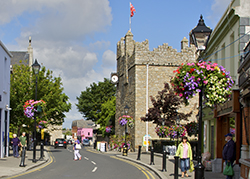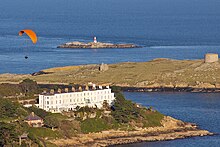Dalkey
Dalkey
Deilginis | |
|---|---|
Suburb (village core) | |
 Castle Street, Dalkey | |
| Coordinates: 53°16′34″N 6°06′14″W / 53.276°N 6.104°W | |
| Country | Ireland |
| Province | Leinster |
| County | Dún Laoghaire–Rathdown |
| Elevation | 26 m (85 ft) |
| Population (2006)[1] | |
| • Urban | 8,083 |
| Eircode (Routing Key) | A96 |
| Area code | 01 (+3531) |
| Irish Grid Reference | O264267 |
Dalkey (/ˈdɔːki/; Irish: Deilginis, meaning 'thorn island') is one of the most affluent suburbs of Dublin,[2][3][4] and a seaside resort southeast of the city, and the town of Dún Laoghaire, in Ireland. It was founded as a Viking settlement and became an active port during the Middle Ages. According to chronicler John Clyn (c.1286–c.1349), it was one of the ports through which the plague entered Ireland in the mid-14th century. In modern times, Dalkey has become a seaside suburb that attracts some tourist visitors. It has been home to writers and celebrities including Jane Emily Herbert, Maeve Binchy, Hugh Leonard, Bono, Van Morrison and Enya. The village and broader area lie within the jurisdiction of Dún Laoghaire-Rathdown County Council.
Etymology
The town is named after Dalkey Island, just off shore. The name is derived from the Irish deilg ("thorn") and the Old Norse ey ("island").
Geography
Dalkey lies by the coast, between Dún Laoghaire (and Sandycove and Glasthule) and Killiney. Off the coast are Dalkey Island (up to the 18th century, also "St. Begnet's Island"), Malden Rock, Clare Rock, Lamb Island, and, further offshore, The Muglins, which have their own lighthouse. The town is on fairly level land, but the district rises to Dalkey Hill (140 m), the northern peak of a ridge which continues to Killiney Hill to the southwest; the two hills are now contained within the public park known as Killiney Hill Park.[5] Along the coast are the natural harbour at Bullock, a couple of small inlets, Sorrento Point just east of the town proper, and the northern park of Killiney Bay.
Local amenities
Quarry

Dalkey Quarry is a disused granite quarry, stone from which was used during the 19th century to build Dún Laoghaire Harbour, and is now a rock climbing location within Killiney Hill Park. During the building of the harbour, the quarry was connected to Dún Laoghaire via a metal tramway known as 'The Metals', some parts of which are still visible in some parts of Dalkey.
Harbours

There are several small harbours on the coast of Dalkey. Bulloch Harbour is the biggest; it is towards the northern part of Dalkey at Harbour Road and is a declared seal sanctuary. Coliemore Harbour is smaller and in the southern part of Dalkey at Coliemore Road. In the Middle Ages, Coliemore was the main harbour for Dublin City. Bulloch Harbour is still a working harbour with boats that fish for lobster and crab, and mackerel in season. It is also used by locals and tourists who hire boats for nearby fishing, sightseeing and for getting to Dalkey Island.
Wildlife
Dalkey Island is home to a colony of seals, and a herd of wild goats also lives on the island.[6] Birdwatch Ireland have established a colony of Roseate Terns on Maiden Rock just north of Dalkey Island. A pod of three bottlenose dolphins also frequents the waters around Dalkey Island.[6]
Education
There are 5 schools in Dalkey: - Loreto Primary School caters for boys from junior infants through first class, and for girls from junior infants through sixth class. - Loreto Abbey Secondary School caters for girls from first year through sixth year. - Harold Boys' National School caters for boys from second class through sixth class. - Saint Patrick's National School caters for boys and girls from junior infants through sixth class. - Castle Park School is an independent school for boys and girls from Montessori to the end of Primary School.
Sports
Cuala CLG, a Gaelic Athletic Association sports club, and Dalkey United, an association football club, are both based at Hyde Park. Early in his soccer career, Paul McGrath played for Dalkey United. In the 1940s, the town produced another international footballer, Peter Farrell. It has set up an athletics club, the Dalkey Dashers. Dalkey Rowing Club is based at Coliemore Harbour and Kayaking is taught at Bulloch. Dalkey Sea Scouts keep two old sailing boats at Bulloch Harbour.
Swimming and diving
The Vico Bathing Place and Whiterock Beach, accessed off Vico Road, offer sea swims. Both have changing shelters.
Sandycove Beach and the adjacent 'Forty Foot' bathing place are a short distance away, beside the Joyce Tower.
Dalkey Sound and the islands beyond are used as scuba diving locations.[7]
Transport

The Dalkey Atmospheric station at Atmospheric Road (29 March 1844 to 12 April 1854)[8] was the terminus for the first commercial application of the atmospheric system of train propulsion.[9]

The current Dalkey railway station was opened on 10 July 1854. The station is served by the DART electric rail system which affords quick access to and from Dublin City Centre. Clifftop views of Dalkey Island and Killiney Bay are afforded as the train emerges from a short tunnel just south of Dalkey Station.
An Aircoach service with a stop at Hyde Road links the area with Dublin Airport. Dublin Bus services 59, 7d and 111 link the area with the nearby seaside town of Dún Laoghaire and the city centre.
People
Dalkey is the original hometown of two Irish writers: novelists Maeve Binchy and playwright Hugh Leonard. It is also the setting for Flann O'Brien's novel The Dalkey Archive. Several well-known Irish and international music figures — including U2 members Bono and The Edge, Enya, Chris de Burgh and Van Morrison — have also bought residences in the area. Film director Neil Jordan lives in the town.
Pat Kenny, former host of RTÉ's flagship chat show The Late Late Show, is a resident, as is the current host, Ryan Tubridy.
Formula One drivers Damon Hill and Eddie Irvine, are former residents, as are singers Lisa Stansfield and Jim Kerr.
James Joyce and George Bernard Shaw also have close associations with the area. Shaw lived in Torca Cottage on Dalkey Hill from 1866 to 1874 and Joyce lived in The Joyce Tower in Sandycove for a time and set the first chapter of his novel, Ulysses, there.
Victoria Cross recipient Major William Leet was born in Dalkey.
Dalkey is also the hometown of Rees Ringrose a computer programmer who was one of the founders of Dropbox.
Culture and tourism

Dalkey's main street, Castle Street, has a 10th Century church and two 14th Century Norman castles, one of which, Goat's Castle, houses the local Heritage Centre (the other, Archbold's Castle, is private property). There are several scenic and historical walks and tours. Dalkey Hill offers views over Dublin city, Dublin Bay, and towards the Dublin and Wicklow Mountains.
Deilg Inis Living History Theatre Company run live theatre performances every half-hour at Dalkey Castle and Heritage Centre.
Boats are available to hire at Bulloch Harbour on Harbour Road and Yacht trips around Dalkey Island can be taken from nearby Dún Laoghaire Harbour. Dalkey Quarry is a rock climbing and abseiling venue. Killiney Hill is also used as a launch site for para-gliders.[citation needed]

Dalkey has a number of pubs and restaurants.
Annual Festivals
Dalkey Book Festival was set up to "celebrate and foster literary talent" in and around the town.[citation needed] The festival takes place over a weekend in Mid-June every year. Festival directors, David McWilliams and Sian Smyth, work with the support of a team of volunteers and the Dalkey Business Group to run the festival. Festival contributors have included Salman Rushdie, Amos Oz, Seamus Heaney, Gabriel Byrne, Edna O'Brien, Roddy Doyle, Maeve Binchy, Joseph O'Connor, Tim Pat Coogan, Derek Landy, Jennifer Johnston, Robert Fisk, Eamon Morrissey, John Waters, Matt Cooper, Julian Gough, Dawn O'Porter and Sinéad Cusack.[citation needed]
The village also hosts the "Dalkey Lobster Festival" in late August, which "showcases local seafood and global jazz musicians".[10]
Saint Begnet
One of the patron saints of Dalkey is St. Begnet, a probable 7th century figure. A ruined church and a holy well on Dalkey Island are named for her, as is another ruined church near the town centre.
King of Dalkey
This putative elective monarchy is a tradition of the people of Dalkey.[11] The freemen of Dalkey inherited the right to elect this King through the boredom of young bloods in Dublin in 1787. They formed a club into which they roped wits, poets and thinkers. They summoned "Pimlico Parliament" - named after the Liberties, Dublin, and from an assembly room they hurled broadsides at the country's humbug and the pomposity of Dublin Castle and its hacks.[citation needed]
The full title is "King of Dalkey, Emperor of the Vikings, Prince of the Holy Island of Magee, Baron of Bulloch, Seigneur of Sandycove, Defender of the Faith and Respector of All Others, Elector of Lambay and Ireland's Eye, and Sovereign of the Most Illustrious Order of the Lobster and Periwinkle." During the years twenty knee-breeched courtiers in 18th century costume attended the King of Dalkey on Coronation Day.[citation needed] In later times the costumes were hired from a theatrical costumiers in Dublin.
More than 420 attended the regal procession, carnival and coronation on 20 August 1797 as Stephen Armitage (pawnbroker and printer) became "King Stephen the First, King of Dalkey". [citation needed] Then came the 1798 Rising and its ensuing political unrest, that interrupted this putative cultural monarchy.[citation needed] However, the tradition was revived in 1934,[12] in 1965, again in 1983, and still continues.[citation needed] The current King is the local sacristan, Finbarr Madden.[13]
Local tradition says that Hugh Dempsey was crowned "King of Dalkey" about 1780.[14] On the south side of the old church lies another stone which says: "This stone was erected by Mr. Murtagh Dempsey of the City of Dublin in Memory of his affectionate son Hugh Dempsey blockmake of said City who departed this Life April 7th 1790."
See also
References
- ^ "Census 2006 – Volume 1 – Population Classified by Area" (PDF). Central Statistics Office Census 2006 Reports. Central Statistics Office Ireland. April 2007. Archived from the original (PDF) on July 17, 2011. Retrieved 2011-06-12.
{{cite web}}: Unknown parameter|deadurl=ignored (|url-status=suggested) (help) Note: The figure given is the sum of the populations of the Dalkey-Avondale, Dalkey-Bullock, Dalkey-Coliemore, Dalkey Hill and Dalkey Upper sections of the area. - ^ "Deprivation Maps for Ireland". Deprivation Index. Trutz Haase. Retrieved 10 March 2017.
- ^ "Popular Dalkey bistro for over €575,000". Irish Times. 5 February 2014.
Dalkey has become .. one of Dublin's most affluent suburbs
- ^ "Rich and famous make their homes in Dalkey". Irish Times. 4 July 1998.
- ^ Dún Laoghaire-Rathdown County Council – Killiney Hill Park
- ^ a b Studio, ClaPat. "Ken The Ferryman". kentheferryman.com. Retrieved 2017-12-03.
- ^ Irish Underwater Council – Dalkey Sound, Dalkey Island, The Muglins
- ^ "Dalkey station" (PDF). Railscot – Irish Railways. Retrieved 2007-08-31.
- ^ Industrial Heritage Ireland
- ^ "Dalkey Lobster Festival | Your Essential Guide 2017". Ireland's Seafood Festivals | Essential Guide. 2016-11-08. Retrieved 2017-12-03.
- ^ http://www.dalkeyhomepage.ie/kingofdalkey.html
- ^ http://www.britishpathe.com/video/dalkey-acquires-a-monarch/query/royalty
- ^ http://www.dalkeycommunitycouncil.com/dccnewsletters/2014/APRIL.pdf
- ^ "KINGS OF DALKEY (1787 to the present day)". www.dalkeyhomepage.ie. Retrieved 2017-12-03.
External links
- . Encyclopædia Britannica. Vol. 7 (11th ed.). 1911.
- Dalkey Community Council
- Local website
- Dalkey Castle and Heritage Centre


